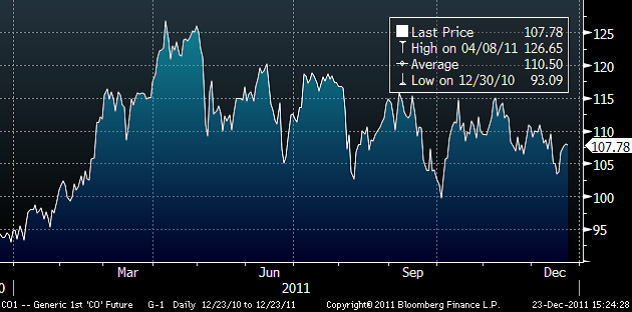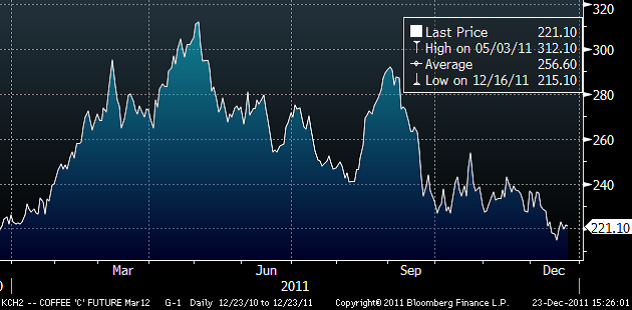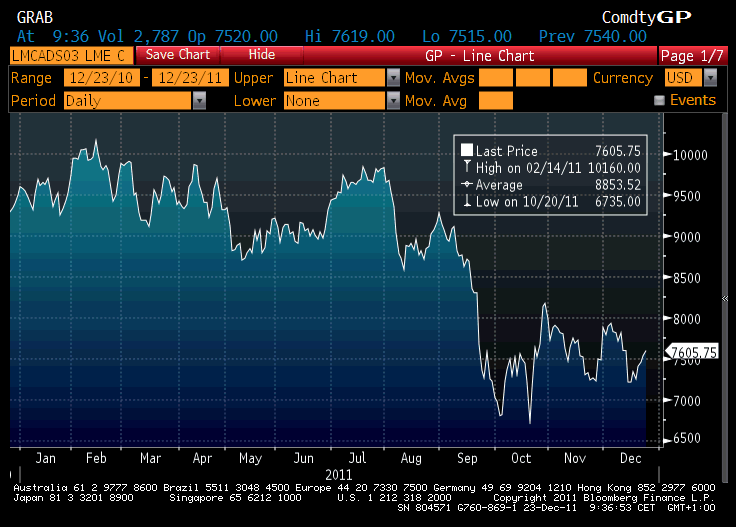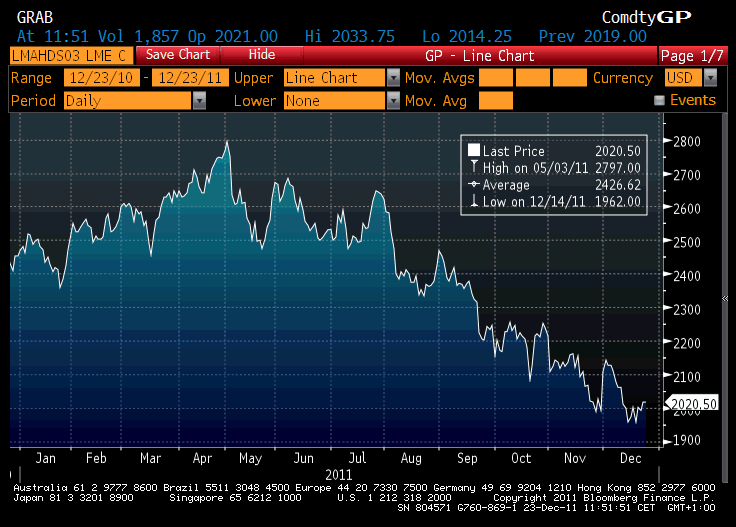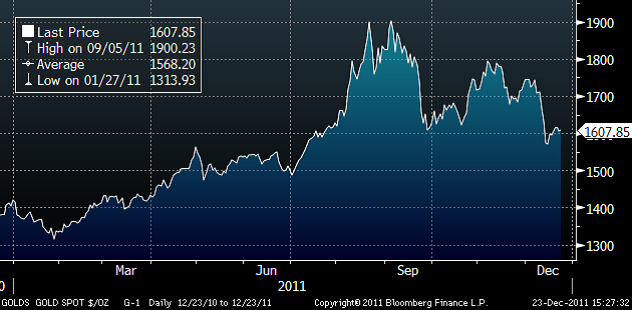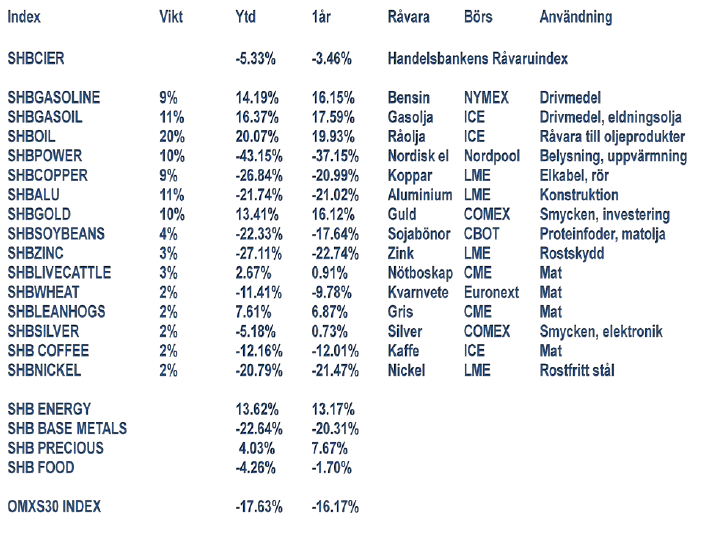Analys
SHB Råvarubrevet 23 december 2011
 Råvarorna har återhämtat något av förra veckans fall med stöd från amerikansk statistik, positiva kinesiska importsiffror och en svagare dollar. Handelsbankens Råvaruindex är nu ned 5.33 procent på året (+2 procent sedan förra fredagen) och det är främst oljan som dragit index. Ekonomiska data i USA fortsätter att vara uppmuntrande. Tillväxten reviderades visserligen ned till 1.8 procent för Q3, mest på grund av lager, men ansökningar om arbetslöshetsunderstöd har minskat till tre års lägsta. Vidare signalerar ledande indikatorer att den ekonomiska tillväxten accelererar. Detta är positivt för oljemarknaden eftersom USA förbrukar lite drygt en fjärdedel av alla oljeprodukter, men vi förväntar oss dock att marknaden kommer att agera fortsatt nervöst om man ser till Europa och dess spridningseffekter till exportberoende länder. Riskerna för det finansiella systemet i Europa är oroväckande och det kommer ta tid att återställa marknadens förtroende. Detta gör att vi nog får se sidledes rörelser en bit in på nästa år. Det som ger gott stöd åt hela segmentet är att råvaror överlag dras med en svag balans som ett resultat av höga produktionskostnader, långa ledtider och vikande halter. Prospekteringstakten måste upprätthållas på en hög nivå för att möta efterfrågan från den växande medelklassen i tillväxtländerna. Detta gör att industrier som maskinell utrustning till gruvindustrin och prospektering exempelvis ser väldigt positivt på framtiden. Komatsu som är världens näst största leverantör av gruvutrustning har haft en tillväxt på närmare 23 procent under 2011 och räknar med 10 procents tillväxt under 2012. Ser vi till Livsmedel så har väder och produktion varit gynnsamt den senaste tiden vilket stärkt lager och utsikterna för att möta efterfrågan. Uppgången den senaste veckan får väl därför betecknas som en short-covering inför årsslutet vilket ofta brukar ge goda möjligheter att positionera sig kort när lugnet lagt sig.
Råvarorna har återhämtat något av förra veckans fall med stöd från amerikansk statistik, positiva kinesiska importsiffror och en svagare dollar. Handelsbankens Råvaruindex är nu ned 5.33 procent på året (+2 procent sedan förra fredagen) och det är främst oljan som dragit index. Ekonomiska data i USA fortsätter att vara uppmuntrande. Tillväxten reviderades visserligen ned till 1.8 procent för Q3, mest på grund av lager, men ansökningar om arbetslöshetsunderstöd har minskat till tre års lägsta. Vidare signalerar ledande indikatorer att den ekonomiska tillväxten accelererar. Detta är positivt för oljemarknaden eftersom USA förbrukar lite drygt en fjärdedel av alla oljeprodukter, men vi förväntar oss dock att marknaden kommer att agera fortsatt nervöst om man ser till Europa och dess spridningseffekter till exportberoende länder. Riskerna för det finansiella systemet i Europa är oroväckande och det kommer ta tid att återställa marknadens förtroende. Detta gör att vi nog får se sidledes rörelser en bit in på nästa år. Det som ger gott stöd åt hela segmentet är att råvaror överlag dras med en svag balans som ett resultat av höga produktionskostnader, långa ledtider och vikande halter. Prospekteringstakten måste upprätthållas på en hög nivå för att möta efterfrågan från den växande medelklassen i tillväxtländerna. Detta gör att industrier som maskinell utrustning till gruvindustrin och prospektering exempelvis ser väldigt positivt på framtiden. Komatsu som är världens näst största leverantör av gruvutrustning har haft en tillväxt på närmare 23 procent under 2011 och räknar med 10 procents tillväxt under 2012. Ser vi till Livsmedel så har väder och produktion varit gynnsamt den senaste tiden vilket stärkt lager och utsikterna för att möta efterfrågan. Uppgången den senaste veckan får väl därför betecknas som en short-covering inför årsslutet vilket ofta brukar ge goda möjligheter att positionera sig kort när lugnet lagt sig.
Energi
Oljemarknaden stöds utöver positiv amerikansk statistik och lägre lager även av fortsatt politisk anspänning i Mellanöstern. Första stora attacken på länge i mot Iraks huvudstad sedan en kris mellan den shiamuslimsk ledda regeringen och sunni-rivaler brutit ut efter ett tillbakadragande av amerikanska trupper förra helgen. Dessutom finns det risk för gnistbildning och att oljeleveranser från viktiga exportmarknader störs av Irans flotta som manövrerar öster om Hormuzsundet.
Lagernivåerna i USA sjönk med 10.6 miljoner fat under veckan vilket är den största fallet på tio år och lagren ligger nu på tre års lägsta. Spreaden mellan WTI och Brent har som ett resultat av detta krupit ihop till 9 dollar. Det spekuleras i om de låga siffrorna är ett resultat av ett något större skatteupplägg än tidigare år, dvs raffinaderiers ”gömda” lager inför årsskifte för att undgå skatt. Detta är tydligt eftersom hela 70 procent av lagerfallet är vid mexikanska golfen där råoljan enkelt kan föras tillbaka till oljetankar. Vi kan mao räkna med att dessa siffror som nu ser bullish ut stiger till något mer neutrala efter årsskiftet. I övrigt noteras även i Nordöstra i USA milda temperaturer och en något lägre efterfrågan på heating oil. Vi trodde att Brent oljan successivt skulle tappa mot slutet av året men nere på 103 dollar (se bilden nedan) fanns det tillräckligt med stöd och intressen vilket innebär att vi nu räknar med neutral till positiv utveckling på kort sikt.
Den Nordiska elmarknaden karaktäriseras fortsatt av milt och blött väder där energibalansen stärkts rejält den senaste månaden. De flesta faktorer pekar nedåt där såväl kontinentala priser, energikol, utsläppsrätter, väder och last gör att vi får räkna med låga priser en tid framöver. Ser vi till prognoserna räknar Shepherd Energy med att vi går mot ett energiöverskott i Norden om hela 8.3 TWh i slutet av vecka 52. Den goda balansen har även pressat den längre kurvan vilket innebär att det om inte annat är ett helt klart intressant läge att låsa in längre elavtal.
Livsmedel
Vetet har stigit kraftigt i pris i både Chicago och Paris under den gångna veckan, påverkat inte minst av stigande priser på majs och flera andra råvaror. Det amerikanska vetet har stigit något mer som följd av en försvagad amerikansk dollar. Vädret är klart bättre i Australien, endast längst ner i söder fortsätter regnet att falla. I Argentina råder fortsatt bra skördeväder och skörden väntas kunna gå mot sitt slut under nästa vecka, med goda volymer och goda kvaliteter som resultat. Temperaturerna har fallit i USA och höstvetet har gått in i vintervila. Enda oron direkt kopplat till vete just nu är väderutvecklingen den närmaste tiden i Ukraina – bristande eller inget snötäcke alls gör grödan mycket känslig mot lägre temperaturer. Trots den styrka priserna visat denna vecka, i en handel som visserligen varit låg volymmässigt, är det svårt att se att priserna ska fortsätta stiga. Faktum kvarstår att vi har en god tillgång på vete, med lagernivåer vi inte sett på över tio år. Fortsatt torrt väder i Sydamerika kan pressa upp majspriserna ytterligare något och eventuellt dra med sig vetepriserna lite till, men marknaden bör nu bli lite mer avvaktande och först se om USDA-rapporten den 12 januari innehåller något överraskande.
Majsen har stigit kraftigt i pris sedan förra veckan, påverkat av fortsatt torrt väder i främst Argentina, en försvagad amerikansk dollar samt stigande priser på råolja. Endast små regnskurar väntas under de kommande 10-14 dagarna, vilket inte lär lindra situationen nämnvärt. Grödan är redan eller är på väg in i ett mycket känsligt utvecklingsstadium. Vad som också gett stöd åt priserna är att siffrorna för den amerikanska veckoproduktionen av etanol rapporterades som de näst högsta någonsin – alltså fortsatt stark inhemsk efterfrågan. Men efterfrågan på amerikansk majs globalt är dock fortsatt ovanligt låg som följd av hård konkurrens. Handeln fram tills USDA:s WASDE-rapport den 12 januari väntas bli ganska avvaktande men om inte läget förbättras i Sydamerika kan priserna stiga lite ytterligare. Analytikerföretaget Informa uppskattar den amerikanska majsarealen 2012 till hela 94,39 miljoner acres, den största arealen sedan 1944! Vissa rykten har dock börjat spridas om att det kommer råda brist på utsäde till våren, vilket om det stämmer givetvis försämrar USA:s chanser att kunna återuppbygga låga lagervolymer.
Sojabönorna har stigit i pris under den gångna veckan, till stor del som följd av fortsatt torrt väder i Argentina, södra Brasilien och även i Paraguay. Viss nederbörd väntas falla i helgen men långt ifrån tillräckligt. Totalt för december månad har nederbörden i flera områden varit mindre än hälften av vad som är normalt. Prisuppgången har även fått hjälp av en försvagad amerikansk dollar och stigande priser på råolja. Sojabönorna lär få stöd av torr väderlek i Sydamerika ett tag framöver men vi får nog vänta lite till innan vi ser någon större uppgång. Vi ska även komma ihåg att läget ännu inte är lika kritiskt för sojabönorna som för majsen, på grund av ett senare utvecklingsstadium.
Kakao handlas ner på spekulation om att avgiftstvisten som stört frakten av bönor från Ghana nu närmar sig sitt slut. Transporterna har inte återupptagits men såväl myndigheter som marknad är positiv till att man löser tvisten med fraktföretagen inom kort. Ghanas export har endast varit 33,000 ton per månad sedan oktober vilket är 63 procent lägre än normalt.
Även Kaffemarknaden ser ut att gå mot balans nästa år efter en längre period av underskott. Kaffe har handlats ned under nio av de senaste tolv handelsdagarna och tappat 8 procent sedan månadsskiftet efter att lågkostnadsproducenter i Centralamerika och Östra Asien dominerat exportmarknaden. Förnyad oro kring produktionen i Colombia efter allt regn har dämpat fallet. I dagsläget osäkert hur mycket stryk plantagen tagit men på flertalet ställen rapporteras om ”Roya” vilket är en svampliknande bildning på bladet som stryper näringen till bönan och minskar avkastningen från trädet. Sett till det stora hela kompenseras ett eventuellt bortfall av goda volymer från Brasilien som förväntas producera 52 miljoner säckar från den kommande skörden vilket är en ökning om 18 procent.
Basmetaller
Kopparpriset har under veckan gått upp från drygt 7 300 USD till dagens nivå på drygt 7 600. Anledningen till uppgången är ett dramatiskt fall i lagernivåerna i framförallt Shanghai, vilket indikerar styrka i den kinesiska ekonomin. Dagens lagernivåer är det lägsta sedan oktober 2009. Vi tror framöver på en försiktig uppgång för kopparpriset, framförallt stött av höga produktionskostnader och fortsatt god efterfrågan från USA och Kina. Det som grumlar bilden något är en mycket svag efterfrågan från Europa, den tredje största förbrukaren i världen.
Kopparpriset sedan december 2010
Aluminium har lyckats kravla sig upp över 2 000 USD/ton och handlar just nu på 2 020 USD/ton. Det verkar finnas ett stöd för ett pris runt 1 950 USD/ton, där priset studsat ett par gånger. Priset fick en skjuts uppåt i slutet förra veckan då det gjordes rekordstora uttaget i lagret i Vlissingen, Nederländerna. Vi ser fortsatt positivt på metallen, då halterna i gruvorna blir allt sämre samtidigt som kostnaden för produktionen är svagt stigande. Vid dessa nivåer drar gruvbolagen ned på produktionen vilket gör att det är svårt för priset att falla ytterligare.
Aluminiumpriset sedan december 2010
Ädelmetaller
Efter att ädelmetallerna fallit kraftigt under mitten av december har prisbilden stabiliserats under den gångna veckan. Euron har stärkts något i relation till dollarn samtidigt som ädelmetallerna överlag handlat sidledes. Guldet har stärkts marginellt (0,5 %), silverpriset är oförändrat och platinapriset har stigit med 0,4 %. Palladium sticker dock ut genom en veckouppgång på 4,1 %.
Vi anser att guldpriset för tillfället står inför ett vägskäl. Om priset bryter igenom den tekniskt viktiga nivån på 1500 USD/oz , samtidigt som problematiken i eurozonen ökar, finns det risk för ytterligare prisfall framöver. Om guldpriset istället lyckas hålla sig över 1500 USD/oz, samtidigt som nästa år istället inleds med stigande börser och en starkare euro, finns möjlighet att priset istället stiger.
Som vi tidigare tagit upp i råvarubrevet har guldpriset för första gången på 26 år blivit dyrare än platina. Denna trend håller fortsättningsvis i sig. I skrivande stund handlas guldpriset på 1611,54 USD/oz (se ovan) och platina på 1439,75 USD/oz.
Handelsbankens Råvaruindex
[box]SHB Råvarubrevet är producerat av Handelsbanken och publiceras i samarbete och med tillstånd på Råvarumarknaden.se[/box]
Ansvarsbegränsning
Detta material är producerat av Svenska Handelsbanken AB (publ) i fortsättningen kallad Handelsbanken. De som arbetar med innehållet är inte analytiker och materialet är inte oberoende investeringsanalys. Innehållet är uteslutande avsett för kunder i Sverige. Syftet är att ge en allmän information till Handelsbankens kunder och utgör inte ett personligt investeringsråd eller en personlig rekommendation. Informationen ska inte ensamt utgöra underlag för investeringsbeslut. Kunder bör inhämta råd från sina rådgivare och basera sina investeringsbeslut utifrån egen erfarenhet.
Informationen i materialet kan ändras och också avvika från de åsikter som uttrycks i oberoende investeringsanalyser från Handelsbanken. Informationen grundar sig på allmänt tillgänglig information och är hämtad från källor som bedöms som tillförlitliga, men riktigheten kan inte garanteras och informationen kan vara ofullständig eller nedkortad. Ingen del av förslaget får reproduceras eller distribueras till någon annan person utan att Handelsbanken dessförinnan lämnat sitt skriftliga medgivande. Handelsbanken ansvarar inte för att materialet används på ett sätt som strider mot förbudet mot vidarebefordran eller offentliggörs i strid med bankens regler.
Finansiellt instruments historiska avkastning är inte en garanti för framtida avkastning. Värdet på finansiella instrument kan både öka och minska och det är inte säkert att du får tillbaka hela det investerade kapitalet.
Analys
Tightening fundamentals – bullish inventories from DOE

The latest weekly report from the US DOE showed a substantial drawdown across key petroleum categories, adding more upside potential to the fundamental picture.

Commercial crude inventories (excl. SPR) fell by 5.8 million barrels, bringing total inventories down to 415.1 million barrels. Now sitting 11% below the five-year seasonal norm and placed in the lowest 2015-2022 range (see picture below).
Product inventories also tightened further last week. Gasoline inventories declined by 2.1 million barrels, with reductions seen in both finished gasoline and blending components. Current gasoline levels are about 3% below the five-year average for this time of year.
Among products, the most notable move came in diesel, where inventories dropped by almost 4.1 million barrels, deepening the deficit to around 20% below seasonal norms – continuing to underscore the persistent supply tightness in diesel markets.
The only area of inventory growth was in propane/propylene, which posted a significant 5.1-million-barrel build and now stands 9% above the five-year average.
Total commercial petroleum inventories (crude plus refined products) declined by 4.2 million barrels on the week, reinforcing the overall tightening of US crude and products.


Analys
Bombs to ”ceasefire” in hours – Brent below $70

A classic case of “buy the rumor, sell the news” played out in oil markets, as Brent crude has dropped sharply – down nearly USD 10 per barrel since yesterday evening – following Iran’s retaliatory strike on a U.S. air base in Qatar. The immediate reaction was: “That was it?” The strike followed a carefully calibrated, non-escalatory playbook, avoiding direct threats to energy infrastructure or disruption of shipping through the Strait of Hormuz – thus calming worst-case fears.

After Monday morning’s sharp spike to USD 81.4 per barrel, triggered by the U.S. bombing of Iranian nuclear facilities, oil prices drifted sideways in anticipation of a potential Iranian response. That response came with advance warning and caused limited physical damage. Early this morning, both the U.S. President and Iranian state media announced a ceasefire, effectively placing a lid on the immediate conflict risk – at least for now.
As a result, Brent crude has now fallen by a total of USD 12 from Monday’s peak, currently trading around USD 69 per barrel.
Looking beyond geopolitics, the market will now shift its focus to the upcoming OPEC+ meeting in early July. Saudi Arabia’s decision to increase output earlier this year – despite falling prices – has drawn renewed attention considering recent developments. Some suggest this was a response to U.S. pressure to offset potential Iranian supply losses.
However, consensus is that the move was driven more by internal OPEC+ dynamics. After years of curbing production to support prices, Riyadh had grown frustrated with quota-busting by several members (notably Kazakhstan). With Saudi Arabia cutting up to 2 million barrels per day – roughly 2% of global supply – returns were diminishing, and the risk of losing market share was rising. The production increase is widely seen as an effort to reassert leadership and restore discipline within the group.
That said, the FT recently stated that, the Saudis remain wary of past missteps. In 2018, Riyadh ramped up output at Trump’s request ahead of Iran sanctions, only to see prices collapse when the U.S. granted broad waivers – triggering oversupply. Officials have reportedly made it clear they don’t intend to repeat that mistake.
The recent visit by President Trump to Saudi Arabia, which included agreements on AI, defense, and nuclear cooperation, suggests a broader strategic alignment. This has fueled speculation about a quiet “pump-for-politics” deal behind recent production moves.
Looking ahead, oil prices have now retraced the entire rally sparked by the June 13 Israel–Iran escalation. This retreat provides more political and policy space for both the U.S. and Saudi Arabia. Specifically, it makes it easier for Riyadh to scale back its three recent production hikes of 411,000 barrels each, potentially returning to more moderate increases of 137,000 barrels for August and September.
In short: with no major loss of Iranian supply to the market, OPEC+ – led by Saudi Arabia – no longer needs to compensate for a disruption that hasn’t materialized, especially not to please the U.S. at the cost of its own market strategy. As the Saudis themselves have signaled, they are unlikely to repeat previous mistakes.
Conclusion: With Brent now in the high USD 60s, buying oil looks fundamentally justified. The geopolitical premium has deflated, but tensions between Israel and Iran remain unresolved – and the risk of missteps and renewed escalation still lingers. In fact, even this morning, reports have emerged of renewed missile fire despite the declared “truce.” The path forward may be calmer – but it is far from stable.
Analys
A muted price reaction. Market looks relaxed, but it is still on edge waiting for what Iran will do

Brent crossed the 80-line this morning but quickly fell back assigning limited probability for Iran choosing to close the Strait of Hormuz. Brent traded in a range of USD 70.56 – 79.04/b last week as the market fluctuated between ”Iran wants a deal” and ”US is about to attack Iran”. At the end of the week though, Donald Trump managed to convince markets (and probably also Iran) that he would make a decision within two weeks. I.e. no imminent attack. Previously when when he has talked about ”making a decision within two weeks” he has often ended up doing nothing in the end. The oil market relaxed as a result and the week ended at USD 77.01/b which is just USD 6/b above the year to date average of USD 71/b.

Brent jumped to USD 81.4/b this morning, the highest since mid-January, but then quickly fell back to a current price of USD 78.2/b which is only up 1.5% versus the close on Friday. As such the market is pricing a fairly low probability that Iran will actually close the Strait of Hormuz. Probably because it will hurt Iranian oil exports as well as the global oil market.
It was however all smoke and mirrors. Deception. The US attacked Iran on Saturday. The attack involved 125 warplanes, submarines and surface warships and 14 bunker buster bombs were dropped on Iranian nuclear sites including Fordow, Natanz and Isfahan. In response the Iranian Parliament voted in support of closing the Strait of Hormuz where some 17 mb of crude and products is transported to the global market every day plus significant volumes of LNG. This is however merely an advise to the Supreme leader Ayatollah Ali Khamenei and the Supreme National Security Council which sits with the final and actual decision.
No supply of oil is lost yet. It is about the risk of Iran closing the Strait of Hormuz or not. So far not a single drop of oil supply has been lost to the global market. The price at the moment is all about the assessed risk of loss of supply. Will Iran choose to choke of the Strait of Hormuz or not? That is the big question. It would be painful for US consumers, for Donald Trump’s voter base, for the global economy but also for Iran and its population which relies on oil exports and income from selling oil out of that Strait as well. As such it is not a no-brainer choice for Iran to close the Strait for oil exports. And looking at the il price this morning it is clear that the oil market doesn’t assign a very high probability of it happening. It is however probably well within the capability of Iran to close the Strait off with rockets, mines, air-drones and possibly sea-drones. Just look at how Ukraine has been able to control and damage the Russian Black Sea fleet.
What to do about the highly enriched uranium which has gone missing? While the US and Israel can celebrate their destruction of Iranian nuclear facilities they are also scratching their heads over what to do with the lost Iranian nuclear material. Iran had 408 kg of highly enriched uranium (IAEA). Almost weapons grade. Enough for some 10 nuclear warheads. It seems to have been transported out of Fordow before the attack this weekend.
The market is still on edge. USD 80-something/b seems sensible while we wait. The oil market reaction to this weekend’s events is very muted so far. The market is still on edge awaiting what Iran will do. Because Iran will do something. But what and when? An oil price of 80-something seems like a sensible level until something do happen.
-

 Nyheter4 veckor sedan
Nyheter4 veckor sedanStor uppsida i Lappland Guldprospekterings aktie enligt analys
-

 Nyheter4 veckor sedan
Nyheter4 veckor sedanSilverpriset släpar efter guldets utveckling, har mer uppsida
-

 Nyheter3 veckor sedan
Nyheter3 veckor sedanUppgången i oljepriset planade ut under helgen
-

 Nyheter3 veckor sedan
Nyheter3 veckor sedanLåga elpriser i sommar – men mellersta Sverige får en ökning
-

 Nyheter2 veckor sedan
Nyheter2 veckor sedanMahvie Minerals växlar spår – satsar fullt ut på guld
-

 Analys3 veckor sedan
Analys3 veckor sedanVery relaxed at USD 75/b. Risk barometer will likely fluctuate to higher levels with Brent into the 80ies or higher coming 2-3 weeks
-

 Nyheter1 vecka sedan
Nyheter1 vecka sedanOljan, guldet och marknadens oroande tystnad
-

 Nyheter1 vecka sedan
Nyheter1 vecka sedanJonas Lindvall är tillbaka med ett nytt oljebolag, Perthro, som ska börsnoteras


